Top 13 Rarest 2-Dollar Bills That Worth Thousands
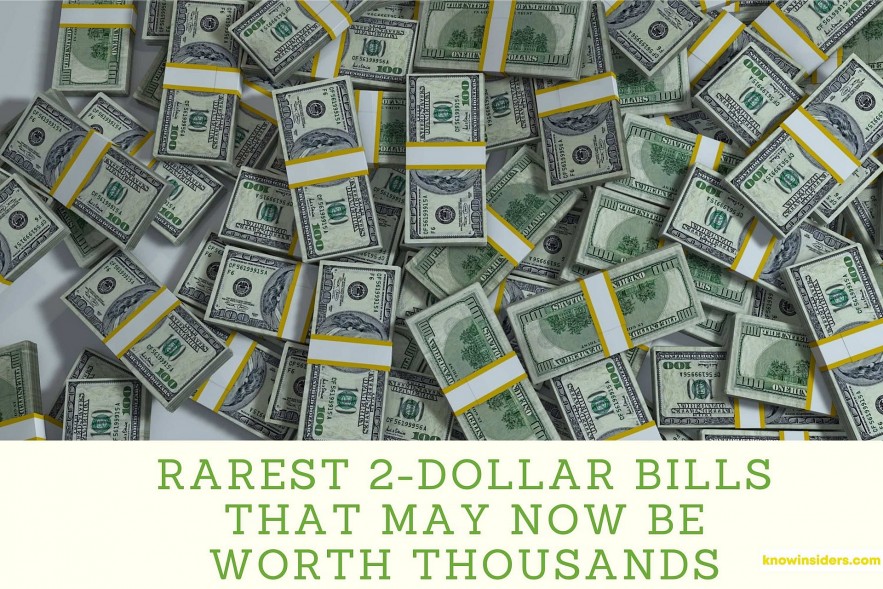 |
| Top 13 Rarest 2-Dollar Bills That May Now Be Worth Thousands. Photo KnowInsiders |
| Contents |
Due to their rarity, some 2-dollar bills' value may be much more than two dollars. In fact, certain cases, these bills can be worth thousands. Like all collectable coins and bills, 2-dollar bill value depends on many factors, including condition, the year of production, and more. The bills aren't easy to find, but they are very special.
Did you recently come across a $2 bill and wonder what it’s worth? You’re not alone… The $2 bill is one of the seemingly most unusual types of banknotes Americans have the pleasure of (occasionally) stumbling upon today. Quite often, the non-collector’s rare encounter with a $2 bill is associated with an event of good tidings – perhaps the $2 bill is a holiday gift, or it’s given to the recipient as part of a tip.
How rare is a 2-dollar bill?
2-dollar bills account for less than 0.001% of all currency in circulation. They are the rarest currently-produced money in the United States, and only about 1.2 billion 2-dollar bills are in current circulation.
That may sound like a lot, but when you compare it to the 11.7 billion 1-dollar bills in circulation, it takes on a new perspective. From the time of its original production in 1862, it has occupied a strange spot in the list of currency denominations. In fact, 2-dollar bills weren't even produced from 1970 through 1975 because of lack of demand.
Check More: How and Why the US Dollar Becomes the Global Currency
How Much Is a 2-Dollar Bill Worth?
Because of its rarity, collectors pay attention to the 2-dollar bill. The rarity doesn't always translate to increased value, but it definitely does sometimes. As with all rare coin values, other factors are also important, including the following:
• Condition - A 2-dollar bill in uncirculated condition will be worth more than one with significant wear.
• Age - Older 2-dollar bills are more valuable than newer ones, as a general rule.
• Serial number - 2-dollar bills feature different serial numbers, some of which are more valuable.
• Misprints - Certain misprints, such as seals that are doubled or not placed properly, are very rare but are valuable.
Top 13 Rarest 2-Dollar Bills That May Now Be Worth Thousands
1. Treasury Note Brown Seal 1890
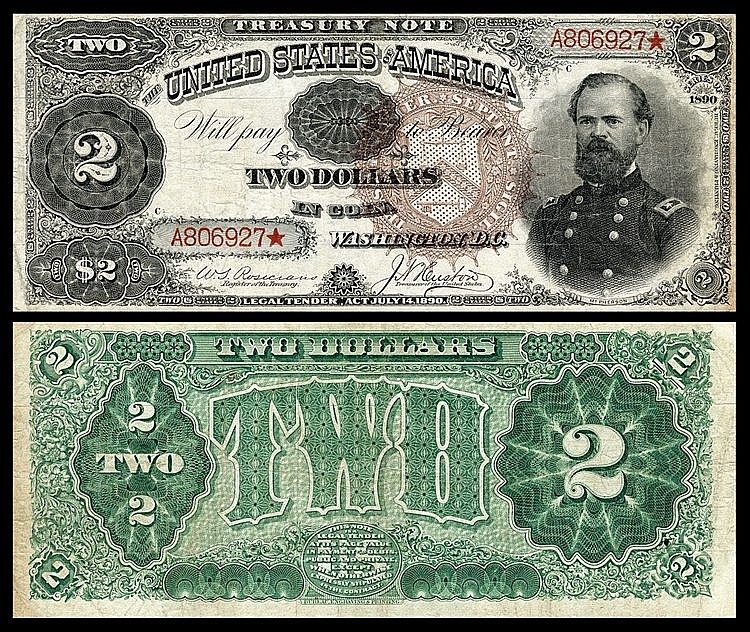 |
| Photo wiki |
Origin: Bureau of Engraving and Printing, United States
Portrait: General James B. McPherson
Value Estimated: $2,000 – $17,000
Treasure notes were only printed in 1890 and 1891, while this $2 has just a little bit over 130 examples of elusive Friedberg numbers. This Rosecrans-Nebeker signed deuce displays the large brown scalloped treasure seal, while General James McPherson is portrayed on the front of the bill. General was the second-highest-ranking Union officer killed during the Civil War. The government used the 1890 series to purchase silver bullion from the mining industry. The notes differ in the large brown or a small red seal.
2. United States Note Red Seal 1869
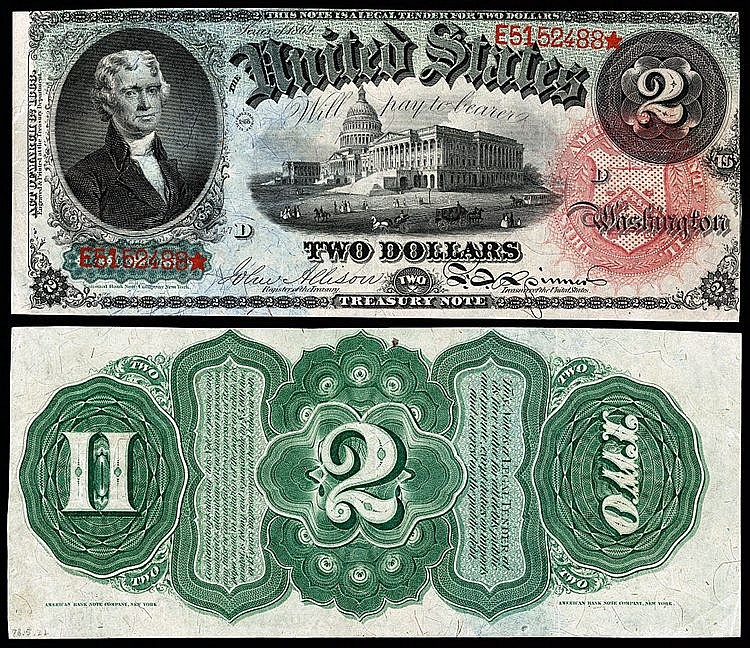 |
| Photo wiki |
Origin: Bureau of Engraving and Printing, United States
Portrait: Thomas Jefferson
Value Estimated: $1,000 – $20,000
The Bureau issued the first $2 bill in 1862. It had Alexander Hamilton‘s portrait, one of the United States’ founding fathers. By 1869, the bill changed its face to a now more common Thomas Jefferson image, which stayed front page even through changes in 1976. However, they reissued it to Federal Reserve Note afterward. Moreover, serial numbers and the treasure seal changed colors from red to green, while the Declaration of Independence replaced the picture of Monticello on the back.
3. United States Note Blue/Brown Seal 1880
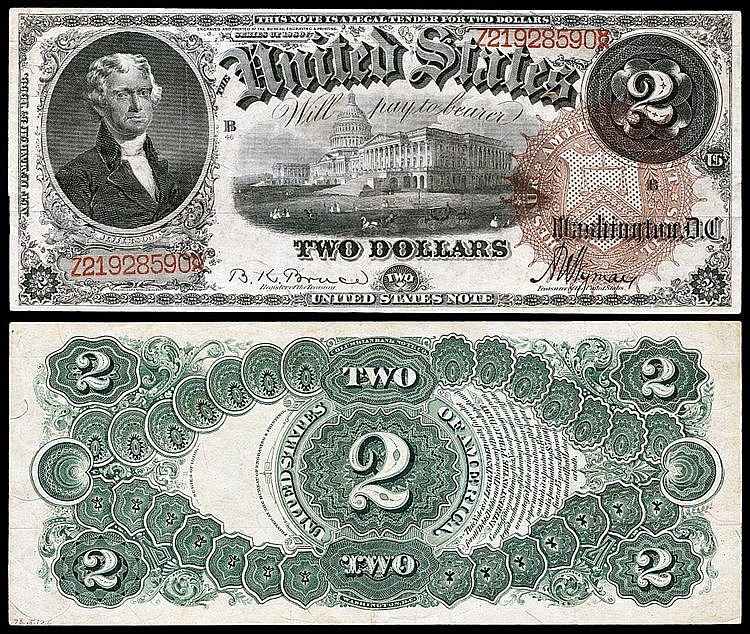 |
| Photo wiki |
Origin: Bureau of Engraving and Printing
Portrait of Thomas Jefferson at left. US Capitol building in center.
Avg Price (Circulated): $500 – $1200
Avg Price (Uncirculated): ± $3800
It features Thomas Jefferson on the left side while the famous Capitol Hill is at its center. To the extreme right of this $2 note, you’ll find a large seal on the obverse. Additionally, you’ll observe that the serial number is in red just below the image of Thomas Jefferson.
Where to Get 2-Dollar BillsYou won't get many 2-dollar bills in change, but they are out there in circulation. If you want to collect newer ones or use 2-dollar bills to give a gift of money, you can ask for them at your bank. They may need to go back to the vault to get them, but most banks have them on hand. You can find collectible 2-dollar bills on auction sites as well. |
4. United States Note Red Seal 1862
 |
| Photo wiki |
Origin: The National Bank Note Company, United States
Portrait: Alexander Hamilton
Value Estimated: $100 – $10,000
The first $2 Legal Tender Note was issued in 1862 by the Federal Government, with a portrait of Alexander Hamilton until Thomas Jefferson took his place in 1869. The back of the note had swirls of number two, earning it a Greenback nickname. After The National Bank Note Company engraved plates necessary for fine printing, the bureau of Engraving and Printing stopped producing the two-dollar denomination.
Uncirculated notes or bills without folds, dirt, or rips can have increased value even up to $10,000. Of course, it can be worth more if the serial numbers are repeated numbers, palindromes or if the serial number includes a star at the end.
| This is the first $2 bills in the US history. They originally featured a portrait of Alexander Hamilton but were later redesigned to portray Thomas Jefferson. Aesthetically, the $2 bill is something to behold. The reverse side features a reproduction of one of the most famous paintings in American history—"Declaration of Independence" by John Trumbull. |
5. United States Note Red Seal 1874
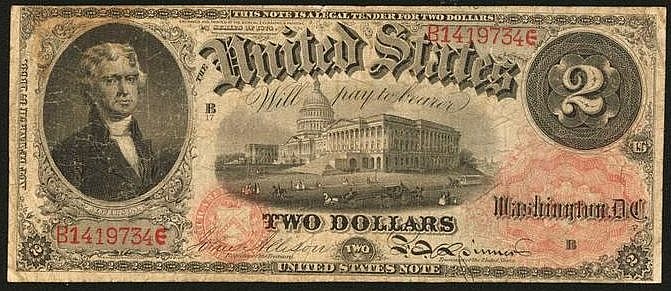 |
| Photo old currency value |
Avg Price (Circulated): $400 – $1000
Avg Price (Uncirculated): ± $2400
Portrait of Thomas Jefferson at left. US Capitol building in center.
Origin: U.S. Department of the Treasury
To give an estimate of this banknote in circulated, average, condition in normal market conditions you would be looking at around $250, while the same note in uncirculated (UNC) condition would be worth around $750. By average condition, we’re talking about the majority of notes in circulation in worn condition, and uncirculated condition meaning it doesn’t have a single fold or abnormality on the bill.
6. United States Note Red Seal 1875B
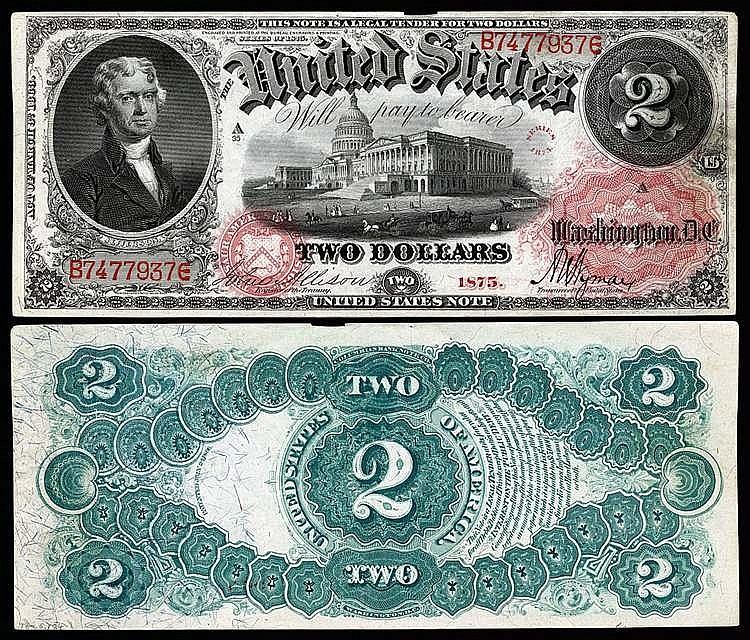 |
| Photo Wiki |
Avg Price (Circulated): $375 – $1100
Avg Price (Uncirculated): ± $2300
Portrait of Thomas Jefferson at left. US Capitol building in center.
Origin: Bureau of Engraving and Printing
With this note, the ambiguity in the 1875 series was dropped in the secondary version. The 1875B series are shinier, fresher, and the paper imprints are clearer. It also features two red seals that are visible with the naked eyes.
How to collect 2-dollar notesAssembling a collection of two-dollar notes is very obtainable for the beginning collector. Start by acquiring a current issue issued between 1976 and today. These include the series 1976, 1995, 2003, 2003A, 2009, and 2013. Collecting one from each of these series is obtainable even on a modest budget. However, these modern issues are usually not found in circulation. Stores and other retailers typically deposit them in the bank and do not request additional two-dollar notes. Mostly this is because there is not a slot for them in the standard cash drawer and a register. Therefore, you will probably have to purchase them from a coin dealer or at a local coin and currency show. Next, obtain the early issue small series notes from each of the series. This includes 1928, 1953, and 1963. Within each one of the series are sub-series that range from A through G. Intermediate and advanced collectors will try to assemble a collection of large size two-dollar notes beginning with the series of 1862. Given the rarity and demand for these notes, a collecting budget of sizable means may be required. |
7. Silver Certificate Red Seal 1896
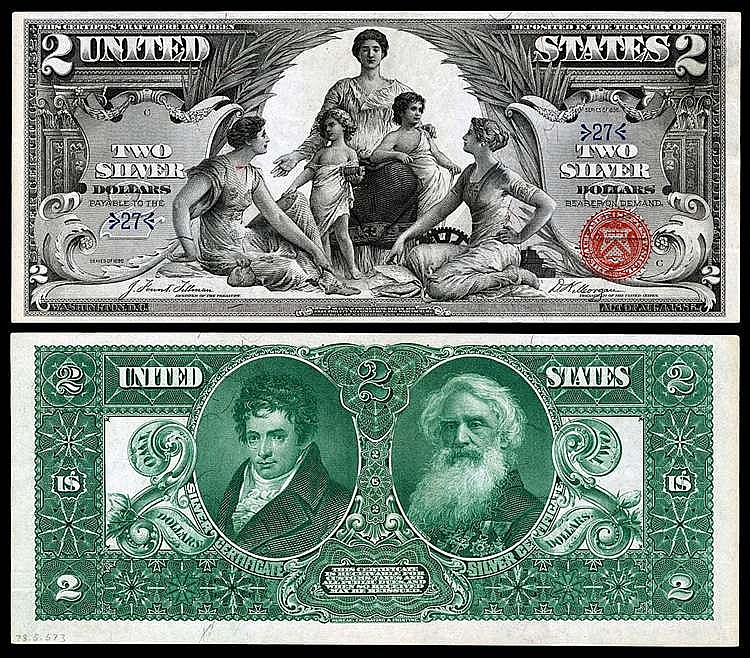 |
| Photo antique money |
Origin: Treasury Department of Bureau of Engraving and Printing, United States
Portrait: Thomas Jefferson
Value Estimated: Depending on the series $10 – a couple of thousand dollars
U.S. currency changed its size in the same year as the United States Note was issued. Thomas Jefferson was on the front of the bill, while the reverse side featured the president’s home, Monticello. The printers engraved this series with a red treasury seal and serial numbers. However, the 1928B star series is the rarest of the entire issue. It is said that this specific series is so rare that there are less than a dozen known to exist. While the 1928B star series is the rarest, the value decreases with the change of the series, with the 1928G being the most common.
Check More: How Many US Dollars Exist in the World?
8. Silver Certificate Red Seal 1891
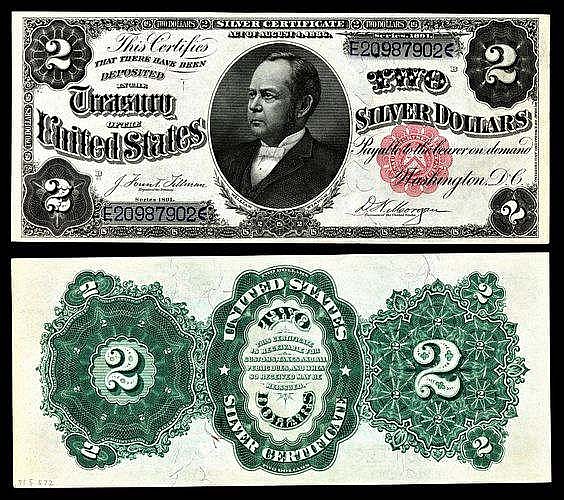 |
| Photo Pinterest |
Avg Price (Circulated): $250 – $900
Avg Price (Uncirculated): ± $2000
Bust of William Windom in center.
Origin: Bureau of Engraving and Printing
A portrait of William Windom occupies the center for the redesigned silver notes. Also, on this note are enlarged waved texts that cover both sides of the portrait. The red seal is located to the right of the note, although slightly below the center on its right section.
9. Silver Certificate Brown Seal 1886
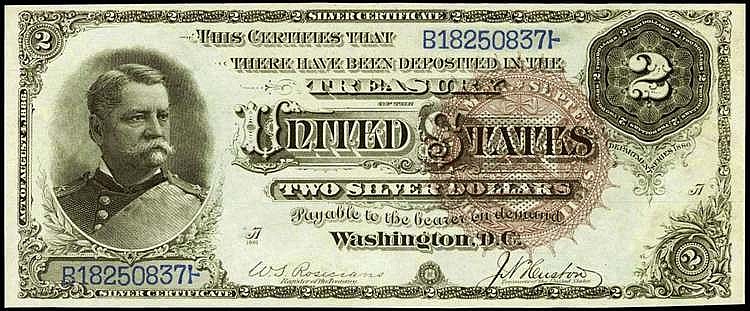 |
| Photo Pinterest |
Avg Price (Circulated): $350 – $900
Avg Price (Uncirculated): ± $1400
Bust of General Winfield Scott Hancock at left.
Origin: Bureau of Engraving and Printing
Winfield S. Hancock’s portrait is placed to the left, while the seal is left to occupy the right side of this note. All the texts in the obverse section are located at the center of the note. Also, declined texts happened to hold the green reverse overprint.
10. Treasury Note Red Seal 1891
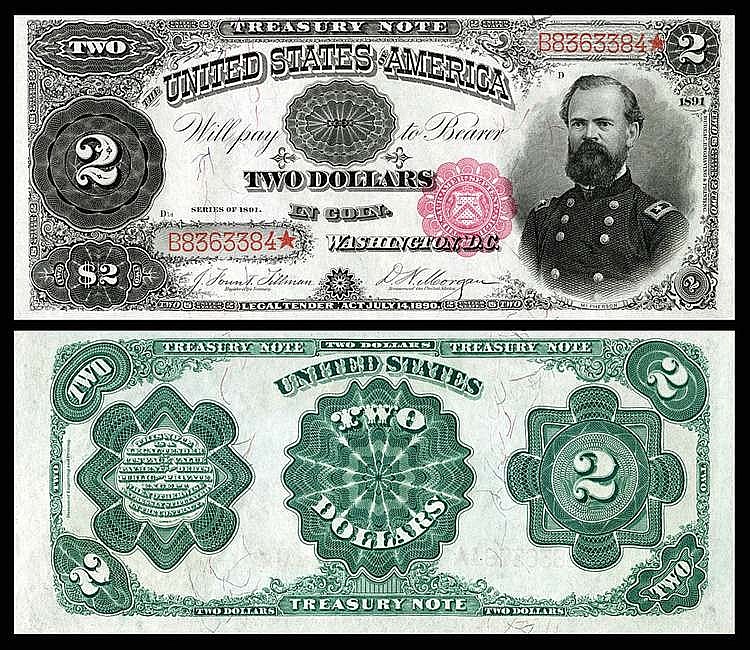 |
| Photo Pinterest |
Avg Price (Circulated): $200 – $750
Avg Price (Uncirculated): ± $1400
Origin: Bureau of Engraving and Printing
Bust of General James McPherson.
Treasury notes were only printed in 1890 and 1891. We are specifically looking at the series of 1891 $2 treasury note. This note has a red seal and red serial numbers. It is larger than paper money is today. Our article has lots of great need to know information about this issue. If we can help you in anyway, please do not hesitate to contact us via email.
There really isn’t an accepted nickname for 1891 $2 treasury notes. Collectors definitely refer to the portrait on the bill as a quick way to identify the item. McPherson was pictured on both the 1890 and 1891 treasury notes so you still have to get a little bit more specific. There is no overriding design element that stands out so for the seeable future we will be talking about 1891 McPhersons.
| It is interesting to note that James B McPherson is the only person to die in the Civil War who was later featured on United States paper money. McPherson was also the second highest ranking Union officer to die in the Civil War. Collecting paper money by portrait has always been an interesting but very challenging way to put together a currency collection. It is also difficult to try to complete a collection of 1891 treasury notes. The $1,000 note is unique and a $500 1891 treasury note has yet to be discovered. Any denomination over $20 is very scarce and rarely seen. |
11. Silver Certificate Red Seal 1886
 |
| Photo old money prices |
Avg Price (Circulated): $350 – $900
Avg Price (Uncirculated): ± $1300
Bust of General Winfield Scott Hancock at left.
Origin: Bureau of Engraving and Printing
All Series of 1886 Silver Certificates are highly desired for their beautifully ornate designs. This 1886 Series included the country's first two dollar denomination for the type. A large red spiked seal complements this catalog number, which features the signatures of Rosecrans and Hyatt. A large portrait vignette of General Winfield Scott Hancock is seen at the left, while the central layout incorporates an appealing styling of "United States." Only a single example is graded finer by PCGS. In this note we offer both quality and rarity and we expect competitive bidding.
Silver Certificates were first issued in 1886 under the title of Silver Certificates of Deposit, such notes being authorized under the Bland-Allison Act of February 28 of that year, best remembered for launching the production of hundreds of millions of Morgan silver dollars. The idea was to have each Silver Certificate backed by an equivalent number of silver dollars held in Treasury vaults.
Silver Certificates proved to be an enduring series and continued well into the 20th century in the form of small size notes. The designs differed from those used on Legal Tender and other currency and were often notable and attractive from a numismatic viewpoint. The 1886 Series notes were the first issued in fairly large quantities.
12. United States Note Red Seal 1875/1875A
 |
| Photo Pinterest |
Avg Price (Circulated): $300 – $650
Avg Price (Uncirculated): ± $1100
Origin: Bureau of Engraving and Printing
Portrait of Thomas Jefferson at left. US Capitol building in center.
This note was somewhat different from the other issuance at the time. You’ll find a large-sized “2” on its front, which earned it the nickname ‘lazy deuce’. Numbers to cover the picture are also placed upward.
13. National Currency/FRBN Blue Seal 1918
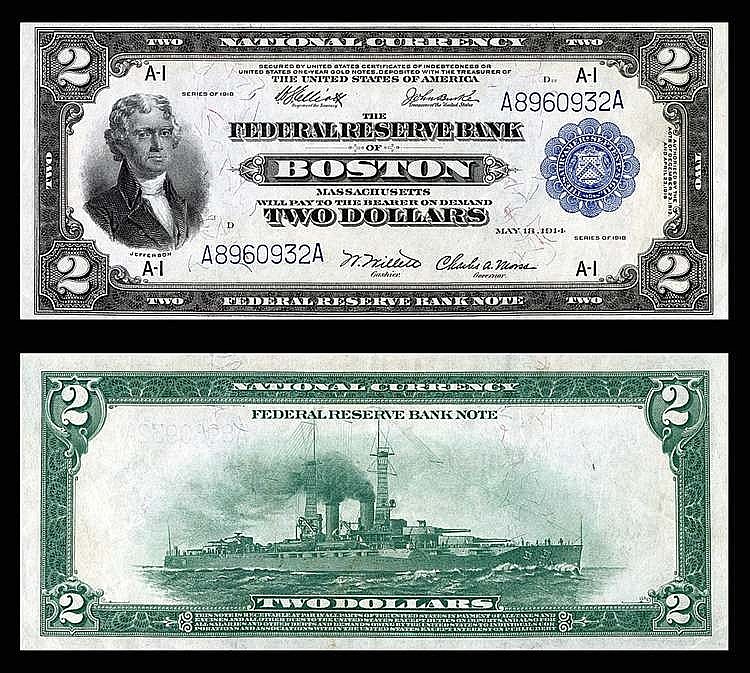 |
| Photo Pinterest |
Avg Price (Circulated): $175 – $375
Avg Price (Uncirculated): ± $1000
Origin: Bureau of Engraving and Printing
Here, you get a thick border note with an image of Jefferson. The reverse displays a battleship to denote WWI. Its notably compacted details with a catchy blue-colored seal make it one highly desired collectible.
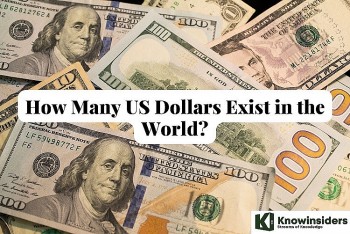 How Many US Dollars Exist in the World? How Many US Dollars Exist in the World? The dollar is the legal tender in the United States. This article list the value and volume of U.S. currency in circulation today. |
 How and Why the US Dollar Becomes the Global Currency How and Why the US Dollar Becomes the Global Currency The US dollar is constantly attracting global savings flows, is the world's main reserve currency and means of payment, and is present in most global ... |
 Top 4 Billionaires In The World With Over $50 Billion Wealth Loss Top 4 Billionaires In The World With Over $50 Billion Wealth Loss The richest men in the world have lost a tonne of money since early this year due to several reasons. Check out who lost the ... |
























